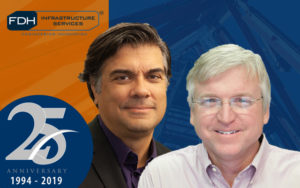FDH Marks 25 Years of Innovation for Critical Infrastructure Posted on Dec 18, 2019
 In a recent episode of FDH TechTalks (listen here), company co-founder Dr. J. Darrin Holt, PE, and Amir Rakha, vice president of foundations infrastructure and nondestructive testing, discuss the company’s innovative roots and commitment to research and development.
In a recent episode of FDH TechTalks (listen here), company co-founder Dr. J. Darrin Holt, PE, and Amir Rakha, vice president of foundations infrastructure and nondestructive testing, discuss the company’s innovative roots and commitment to research and development.
Dr. Holt, who received his civil engineering degrees from North Carolina State University, developed the proprietary nondestructive test (NDT) method for which the company is known. Rakha, a computer science engineer from Iowa State University, is helping commercialize the company’s proprietary NDT methods for new markets.
In the Beginning
FDH was founded in 1994 when Dr. John Fisher, PE, a professor at NC State, learned that the North Carolina Department of Transportation (NCDOT) had a problem. As Dr. Holt tells it, many of the state’s bridges ”were sitting on wood poles or timber piling, and [the DOT] didn’t know how long or how deep they were in the ground because some of these bridges were extremely old” and the as-built drawings were lost. A nondestructive solution was needed that could determine bridge pile depth and condition without disturbing the structure.
Dr. Fisher enlisted the help of another professor at the university, Dr. Robert Douglas, an expert in wave propagation mechanics. After Dr. Fisher secured funds from NCDOT and the Federal Highway Administration through a research grant, the two professors brought in Darrin Holt, then a PhD student. As Dr. Holt tells it, originally, we were just trying to do the research, but then we realized “hey, this might actually work…maybe we can make a company out of this and offer it to the practicing engineer.”
The project was a success. FDH developed a series of proprietary nondestructive evaluation (NDE) techniques using dispersive wave propagation that not only resolved the problem of unknown bridge foundations but also laid the groundwork for a new company and new research applications.
Flashforward to Today
Today, FDH continues to work in partnership with universities and government research programs to refine and validate its nondestructive evaluation and testing methods for various infrastructure markets. In addition to numerous patents, these innovations have led to new proprietary methods adopted by asset owners to mitigate risk and extend the life of critical infrastructure.
In the early days, Dr. Holt was FDH’s only employee. These days, however, the company has entire departments and PhD-level engineers devoted to researching and developing new engineering methods to test critical structures, evaluate their viability, and make recommendations to extend their lifespans.
Posing the Right Questions
Over the years, FDH has developed a reputation for asking the right questions, enabling them to devise innovative solutions to complex engineering problems. Early in his career, Dr. Holt helped build the indoor/outdoor research laboratory where the company’s research engineers test and validate new NDE techniques that address customer needs.
That practical, hands-on approach combined with extensive field applications has led to the accumulation of a vast library of knowledge. As Rakha says, “That gives us the ability to go to new customers and say, ‘Where are your problems? What do you need solved?’ Then the researchers on staff use this library of knowledge to push the technology forward.”
Cutting-Edge Techniques Go Global
FDH has applied its groundbreaking NDE techniques to a wide variety of exciting projects, including aging cell towers and foundations, major navigational and flood control dams, transmission towers, wind turbine foundations and towers, and more. This same pioneering spirit continues today.
Understanding the data is critical to helping customers know where to focus their limited operations and maintenance dollars. Rahka explains how FDH engineers are expanding their core technology by implementing pattern recognition AI software that analyzes wave patterns and makes recommendations based on critical data points.
Rakha says the power of data is why FDH is adding structural health monitoring (SHM) to its service offerings. The combination of NDT and SHM data creates a rich knowledge base by which “we can warn people of issues associated with infrastructure before it really becomes a big problem.”
These advances have led to opportunities in the international market. FDH is currently exploring a new partnership to provide foundation investigation and mapping services globally, beginning with Southeast Asia.
The Right People Lead to Evergreen Capabilities
Retired since 2015, Dr. Holt believes the nondestructive technology FDH has developed is perpetual. “It’ll continue to find problems. And when it finds the problem, it will solve it…. All you have to do is have the right people at the helm, the right people in the laboratory, the right people at the desk doing the mathematics, and it will continue to grow.”
Stay tuned for many more years of advanced innovations!
To listen to the full conversation, along with other podcasts, visit https://www.fdh-is.com/resources/podcast-series/.
Copyright 2024 FDH Infrastructure Services. All Rights Reserved. Privacy Policy | Terms of Use
